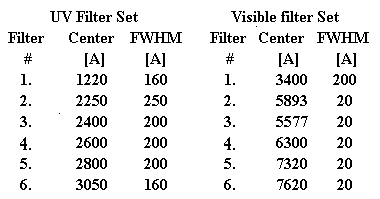
Due to the nightime launch requirement a "rare" opportunity exists for coordinated ground based airglow and auroral measurements in the northern hemisphere. The GLO instrument can view in many directions but will nominally view the limb. The orbiter will reach a maximum latitude of 51.6 deg. N in the dark, 27 deg. before reaching the a.m. terminator crossing. As GLO's line of sight will be tangent to the 100 km layer at a depression angle of ~16 deg. limb auroral and airglow observations will be possible up to ~68 deg. N latitude.
THE GLO INSTRUMENT
The GLO Instrument has a set of imaging spectrographs that
simultaneously observe the entire wavelength range from 1150 Angstroms to
1.1 micrometers at a resolution off ~5 Angstroms in the UV and visible
to ~10 Angstroms in the near IR. The instrument is also equipped with a
set of 15 imagers; 3 that observe in the red - near IR with wide,
medium, and narrow fields of view and 12 that are intensified and
fitted with band-pass filters as follows:

The field of view of each of the set of 9 co-aligned spectrographs is 0.2 X 8ø, while the field of view of each of the monochromatic imagers is 15 X 17.
We have improved the capability of the experiment by adding star tracking. This allows us to make absolute absorption measurements on the top side of the neutral atmosphere by tracking stars into the limb. Stars are used as calibration sources. By selecting a star of the proper type, emission can be recorded simultaneously across the 9 segments of the spectrum, solving the cross-over problem from segment to segment. We have also implemented limb tracking to remove the limit cycle of the shuttle from the data as it is being recorded.
As already mentioned STS-63 will rendezvous with the MIR space station, so the orbit is fixed within a five minute launch window. The orbiter will reach a maximum latitude of 51.6 deg. N in the dark, 27 deg. before reaching the a.m. terminator crossing. The a.m. terminator crossing will occur at a latitude of 42 deg. N, while the p.m. terminator crossing will be at 42 deg. S. The maximum southern latitude of 51.6 deg. S will be reached in daylight.
 Click the icon to leave any comments or suggestions you may have.
Click the icon to leave any comments or suggestions you may have.
 Back to LPL-West
Spaceflight page
Back to LPL-West
Spaceflight page